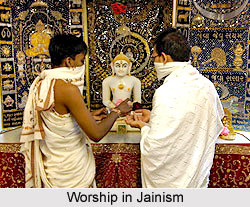 Rituals are an integrated part of daily life of a Shravaka. In house hold activities, clean the stoves, before lighting, sweep the floor, filter the water boil the water for sadhus, spreading grains for birds first few things to be done. For very pious jains perform pratikraman and samayik etc. The most prominent rites amongst Jains are worship of idols.
Rituals are an integrated part of daily life of a Shravaka. In house hold activities, clean the stoves, before lighting, sweep the floor, filter the water boil the water for sadhus, spreading grains for birds first few things to be done. For very pious jains perform pratikraman and samayik etc. The most prominent rites amongst Jains are worship of idols.
1. Daily Puja or Worship
2. Special (parva) Puja or Worship
Daily Puja
In Pujan one worships idol with eight fold offerings. Each puja has specific significance. There are eight karmas and to destroy them one performs eight kinds of pujas.
Jala (Water) Puja: Water symbolizes the ocean. Every life form continuously travels through Ocean of birth, life, death, and despair. This puja reminds that one should live the life with honesty, truthfulness, love and compassion towards all life forms. This way one will be able to cross the Life Ocean and achieve Moksha or nirvana. The path of nirvana is Samyak Darshan, Samyank Gyan and Samyak Charitra in Jain religion.
Chandan (Sandal-wood) Puja: Chandan symbolizes Knowledge (Gyan). During this puja, one should reflect on Right Knowledge. Right knowledge means proper understanding of reality which includes Soul, Karma, and their relationship. Jainsim believes that the Pat of Knowledge is the main path to achieve nirvana. Bhakti or Devotion helps in the early stages of one`s effort for nirvana.
Pushpa (Flower) Puja: Flower symbolizes conduct. Our conduct should be like a flower, which provides fragrance and beauty to all life forms without discrimination. One should live his life like flowers with full of love and compassion towards all life forms.
Dhup (Incense) Puja: Dhup symbolizes ascetic life. While burning itself, Dhup provides fragrance to others. Similarly true monks and nuns spend their entire life selflessly for the benefit of all life forms. This puja reminds that one should thrive for an ascetic life which eventually leads to nirvana.
Deepak (Candle) Puja: The flame of Deepak or candle represents a Pure Consciousness or a Soul without any bondage. It can also be an enlightened Soul. In Jainsim, such a soul is called Siddha or God. The ultimate goal of every living being is to become enlightened from karma. By performing this puja, one must try to follow the Five great Vows: of Ahimsa, Truthfulness, Non-stealing, Chastity, and Non- possession. This would help in achieving nirvana.
Akshat (Rice) Puja: The family rice is the kind of grain seeds, which is regarded as non- fertile. One can`t grow rice plants by seeding the family rice. Thus, symbolically this means that rice is the last birth. By performing this one must try to put all the efforts in the life in such a way that this life would become his last life. He must try to be liberated and escape from the cycle of birth and death.
Naivedya (Sweet) Puja: Naivedya symbolizes a tasty food. By performing this puja, one must try to reduce his attachment towards tasty food. Healthy food is required for survival but one should no live for eating tasty food. The ultimate objective in one`s life is to achieve a life where no food is necessary for existence. That is the life of enlightened soul.
Fal (Fruit) Puja: Fruit symbolizes Moksha or Nirvana. One must live his life without any attachments to corporeal affair, continue to perform our duty without any expectation and reward, truly follow ascetic life, and bestow love and compassion to all. This would help in achieving the fruit of nirvana or Moksha. This is the last puja symbolizing the ultimate achievement of our life.
Vandan Kirtan
 After the completion of idol worship devotees perform bahv puja, recite studies, do chaitya vandan etc. These rituals help in two ways. Firstly, one feels happy and experiences ultimate joy. Secondly, it helps in destroying kashayas, plant seeds of good qualities and destroys karmas. Aarati is usually done in evening. It symbolizes the joy after performing all religious activities in temple. Sthanakvasi and Terapanthi do not believe in idol worship. They just stay in upashraya and do dharma i.e. religious activities.
After the completion of idol worship devotees perform bahv puja, recite studies, do chaitya vandan etc. These rituals help in two ways. Firstly, one feels happy and experiences ultimate joy. Secondly, it helps in destroying kashayas, plant seeds of good qualities and destroys karmas. Aarati is usually done in evening. It symbolizes the joy after performing all religious activities in temple. Sthanakvasi and Terapanthi do not believe in idol worship. They just stay in upashraya and do dharma i.e. religious activities.
Special Pujas
These pujas are performed on special occasions or on special days.
Snatra Puja: It symbolizes bathing the new Tirthankaras by devas and devies over mountain meru. This puja is performed prior to any puja, on birthday celebrations, during opening of new business, and housewarmings etc.
Panch Kalyanak Puja: This puja commemorates the five great events in the Ttirthankara`s life. This puja is performed during any good event. The Panch or Five kalyanks are conception, birth, renunciation, nirvana, and Moksha.
Antaray Karma Puja: There are eight pujas that resemble the daily Ashta Prakari Pooja. These pujas mention about how different people create the antraykarmas and are finally able to remove those obstacles after performing these pujas. There are other pujas namely, Navpad puja, Barvrata puja, Navvanu meaning ninety-nine Prakari puja.
Pujan: This is a very lengthy puja that almost lasts a whole day. It is executed by very learned persons and involves many people in a ceremony. This is performed during new temple opening ceremony, after someone`s special penance etc.




















